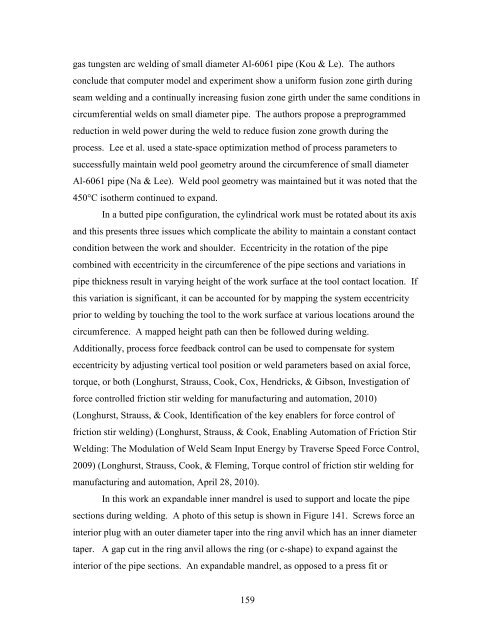D.H. Lammlein PhD Dissertation - Vanderbilt University
D.H. Lammlein PhD Dissertation - Vanderbilt University
D.H. Lammlein PhD Dissertation - Vanderbilt University
Create successful ePaper yourself
Turn your PDF publications into a flip-book with our unique Google optimized e-Paper software.
gas tungsten arc welding of small diameter Al-6061 pipe (Kou & Le). The authors<br />
conclude that computer model and experiment show a uniform fusion zone girth during<br />
seam welding and a continually increasing fusion zone girth under the same conditions in<br />
circumferential welds on small diameter pipe. The authors propose a preprogrammed<br />
reduction in weld power during the weld to reduce fusion zone growth during the<br />
process. Lee et al. used a state-space optimization method of process parameters to<br />
successfully maintain weld pool geometry around the circumference of small diameter<br />
Al-6061 pipe (Na & Lee). Weld pool geometry was maintained but it was noted that the<br />
450°C isotherm continued to expand.<br />
In a butted pipe configuration, the cylindrical work must be rotated about its axis<br />
and this presents three issues which complicate the ability to maintain a constant contact<br />
condition between the work and shoulder. Eccentricity in the rotation of the pipe<br />
combined with eccentricity in the circumference of the pipe sections and variations in<br />
pipe thickness result in varying height of the work surface at the tool contact location. If<br />
this variation is significant, it can be accounted for by mapping the system eccentricity<br />
prior to welding by touching the tool to the work surface at various locations around the<br />
circumference. A mapped height path can then be followed during welding.<br />
Additionally, process force feedback control can be used to compensate for system<br />
eccentricity by adjusting vertical tool position or weld parameters based on axial force,<br />
torque, or both (Longhurst, Strauss, Cook, Cox, Hendricks, & Gibson, Investigation of<br />
force controlled friction stir welding for manufacturing and automation, 2010)<br />
(Longhurst, Strauss, & Cook, Identification of the key enablers for force control of<br />
friction stir welding) (Longhurst, Strauss, & Cook, Enabling Automation of Friction Stir<br />
Welding: The Modulation of Weld Seam Input Energy by Traverse Speed Force Control,<br />
2009) (Longhurst, Strauss, Cook, & Fleming, Torque control of friction stir welding for<br />
manufacturing and automation, April 28, 2010).<br />
In this work an expandable inner mandrel is used to support and locate the pipe<br />
sections during welding. A photo of this setup is shown in Figure 141. Screws force an<br />
interior plug with an outer diameter taper into the ring anvil which has an inner diameter<br />
taper. A gap cut in the ring anvil allows the ring (or c-shape) to expand against the<br />
interior of the pipe sections. An expandable mandrel, as opposed to a press fit or<br />
159
















